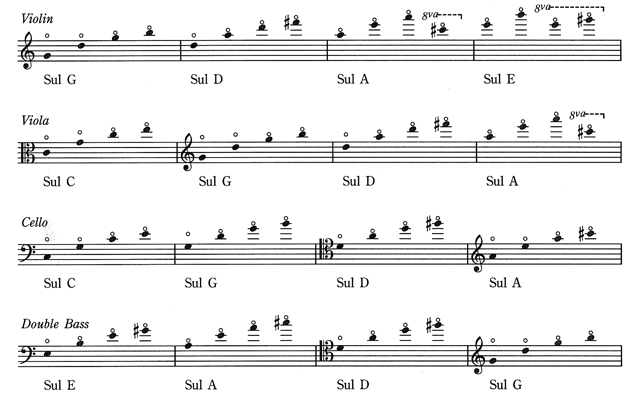The String Section, Terminology and Effects
The String Section
The string section is the largest group of similar instruments in the orchestra and for many reasons the most frequently employed. First and second violins form two separate sections, which can be compared to soprano voices in range. The violas provide alto or tenor range voices, and the cello section typically covers lines in the tenor and bass regions. Any of these instruments can be used in their upper range, becoming a more prominent voice in the texture. The double basses are a true bass voice for the section, sounding an octave below their written pitch. Some of the features of the strings that have made them the mainstay of the orchestra are listed below:
- Strings are able to play continuously for long periods and can produce a sustained tone.
- They have an enormous range of dynamic possibilities, from a whisper to a vibrant, full fortissimo.
- The range in pitch they cover as a section is among the widest in the orchestra.
- Virtually all types of technical maneuvers are effectively produced: fast passages, slow cantabile melodies, short or long tones, trills, tremolos, and chords.
- Because of the vibrato, blend, and warmth of colors, strings do not tire the ear.
String Terminology and Effects
- Vibrato: A normal part of the string sound. Although a pitch is available as an open string, pitches are usually fingered on a lower string. Open strings are avoided because vibrato cannot be introduced. Indicate nonvibrato if that is the desired effect.
- Divisi: Division of a group of like string instruments into two or more parts, each with a different pitch.
- Multiple stops: The simultaneous sounding of two, three, or four tones is possible on a single instrument (nondivisi). The easiest are double stops with an open string. The most difficult are triple and quadruple stops in which each note is fingered. It is impossible to bow multiple stops on other than adjacent strings or on the same string. Thirds, sixths, and tenths are highly recommended intervals. Octaves, perfect fourths, and perfect fifths are more difficult to play in tune.
- Arco: Bowed; the ordinary method of tone production.
- Pizzicato: Plucked with the flesh of a finger.
- Left-hand pizzicato: Indicated by a cross (+) above the note; most effective on open strings.
- Bowed tremolo: Rapid alternation of up and down bows on a single pitch. Measured tremolo consists of even division of note values and is represented by two slashes through the stem. Unmeasured tremolo, represented by three slashes, calls for uneven division of the pulse and produces a jerky effect.

FIGURE 2.1 Bowed tremolo
- Fingered tremolo: Changing pitches; similar to a trill, but at an interval greater than a second.

FIGURE 2.2 Fingered tremolo
- Bariolage: Alternating between two strings; usually one is open.
- Mute (sordino, Dampfer): A small rubber device that sits on strings near the bridge or clamps onto the bridge and deadens the sound.
- Sul ponticello (am Steg): Bow or pluck near the bridge.
- Sul tasto (am Griffbrett): Bow or pluck over the fingerboard.
- Col legno (mit Holz): Wood, rather than hair, of bow used.
- Modo ordinario (ord.): Cancels effects, such as bowing in other than ordinary fashion.
- Scordatura: Other than normal tuning of string; false tuning.
- Glissando (portamento): Smooth slide, sounding pitches between two notes.
Harmonics
Natural Harmonics
Natural harmonics are overtones of an open string, divided by light pressure on a node, commonly one-half, one-third, one-fourth, or one-fifth of the string’s length. The pitch that sounds is notated, and a small “0” is placed over the note. If a particular string is to be used, its name is indicated (i.e., “suI G” or “suI D”).

FIGURE 2.3 Example of natural harmonics notated
The following table shows the first four harmonics of open strings on the violin, viola, cello, and double bass.

FIGURE 2.4 Table of natural harmonics
Artificial Harmonics
Artificial harmonics are overtones of stopped or fingered pitches; touching the string a perfect fourth above the stopped note produces a pitch two octaves above the stopped note.

FIGURE 2.5 Example of artificial harmonics notated
